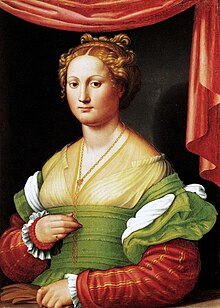You can help expand this article with text translated from the corresponding article in Italian. (December 2022) Click for important translation instructions.
|
| Vannozza dei Cattanei | |
|---|---|
 | |
| Born | Giovanna dei Cattanei (1442-07-13)13 July 1442 Mantua, Margraviate of Mantua |
| Died | 24 November 1518(1518-11-24) (aged 76) Rome, Papal States |
| Nationality | Italian |
| Spouses |
|
| Partner | Cardinal Rodrigo de Borgia, later Pope Alexander VI (lover) |
| Children | By Pope Alexander VI Cesare Borgia Giovanni Borgia Lucrezia Borgia Goffredo Borgia By Giorgio di Croce Ottavio di Croce |
Giovanna "Vannozza" dei Cattanei (13 July 1442 – 24 November 1518) was an Italian woman who was the chief mistress of Cardinal Rodrigo de Borgia, later to become Pope Alexander VI.
Early life
Born in 1442, most likely in Mantua, Vannozza moved to Rome where she was landlady of several inns (Osterie), at first in the Borgo, then in Campo de' Fiori.
Relations with Rodrigo de Borgia
Vannozza's relationship with Cardinal Rodrigo de Borgia began sometime between 1466 and 1472. She is believed to have married Domenico d'Arignano, an officer of the Church, perhaps in 1473, possibly at the arrangement of Borgia.
She bore four children whom Borgia openly acknowledged as his:
- Cesare (1475–1507)
- Giovanni (1476–1497), 2nd Duke of Gandia
- Lucrezia (1480–1519)
- Goffredo (1481–1517)
Domenico died before Giovanni was born. In 1480 Borgia arranged Vannozza's marriage to Giorgio di Croce, for whom he had procured a position as apostolic secretary. During the marriage to Giorgio, Vannozza had a son, Ottavio or Ottaviano, who did not live long. In 1486 Giorgio died and Vannozza married Carlo Canale.
American author G. J. Meyer claims that the birth dates of the four in comparison with Alexander's known whereabouts actually preclude him having fathered any of them.
Later life
After his elevation to the papacy, Borgia's passion for Vannozza somewhat diminished, and she subsequently led a very retired life. However, Borgia's love for his children by Vannozza remained as strong as ever; it proved, indeed, the determining factor of his whole career. He lavished vast sums on them and lauded them with every honour. She, too, remained the matriarch of the Borgia family and influential during the papacy of Rodrigo Borgia.
Vannozza died in 1518 and was buried in the Basilica of Santa Maria del Popolo in Rome.
Arnold Mathew wrote:
"Vannozza breathed her last at Rome, 26 November 1518, at the age of seventy-six. She was buried with conspicuous honours 'almost like a Cardinal' in the Church of Santa Maria del Popolo, near her son, the Duke of Gandia. An official character was imparted to the ceremony by the presence of the papal Court. Pope Leo X in this way recognised Vannozza either as the widow of Alexander VI or as the mother of the Duchess of Ferrara."
In fiction
In the 2006 Canadian/German film The Conclave, she is played by Nora Tschirner. In Showtime's 2011 series The Borgias, she is played by Joanne Whalley. In Borgia, the Canal+ production of the same year created by Tom Fontana, she is played by Assumpta Serna.
Notes
- Or Ottaviano
- Gregorovius 1904, p. 10–11.
- ^ Cloulas 1993, p. 51.
- ^ Locklin 2000.
- Cloulas 1993, p. 45.
- Gregorovius 1904, p. 11-12.
- Catholic University of America 2003.
- Gregorovius 1904, p. 12.
- Cloulas 1993, p. 52.
- G. J. Meyer (2014). "Background: The paternity question: An apology". The Borgias: The Hidden History. Bantam. pp. 239–247. ISBN 978-0345526922.
- Cloulas 1993, p. 299.
- Mathew, p. 374.
References
- Gregorovius, Ferdinand (1904). Lucrezia Borgia. New York: Benjamin Blom. Retrieved August 1, 2014.
- Cloulas, Ivan (1993). The Borgias. New York: Barnes & Noble. ISBN 978-0-88029-806-3.
- Locklin, Nancy L. (2000). "Borgia, Lucrezia (1480–1519)". In Commire, Anne; Klezmer, Deborah (eds.). Women in World History: A Biographical Encyclopedia. Vol. 2. Gale. Archived from the original on 2015-03-29. Retrieved 2 September 2014.
- Catholic University of America (2003). "Borgia (Borja)". New Catholic Encyclopedia. Vol. 2 (2 ed.). Detroit: Gale. Archived from the original on 2015-09-24. Retrieved 2 September 2014.
- Mathew, Arnold H. The Life and Times of Rodrigo Borgia. Southampton Times Limited.
Sources
- Spinosa, Antonio (1999). La saga dei Borgia. Mondadori.
- Los Borgia, Juan Antonio Cebrián, Temas de Hoy, 2006. ISBN 84-8460-596-5